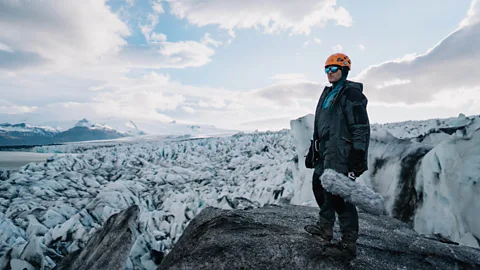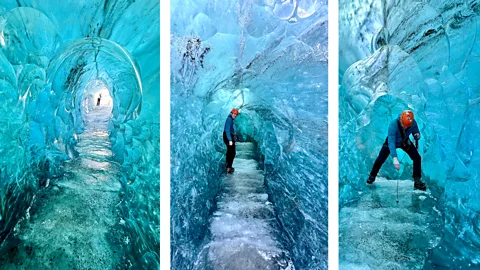Deep in the rugged wilderness of Iceland, where glaciers once stood as timeless monuments of ice and cold, a new story is unfolding — one told not through sight but through sound. As the world’s climate warms and these ancient ice giants retreat at an alarming pace, a unique journey is underway to capture their voices before they fade forever. Driven by a fascination sparked by a haunting track from the Icelandic band Sigur Rós, researcher Konstantine Vlasis has dedicated himself to recording the subtle symphony of melting glaciers and intertwining it with Iceland’s rich tradition of folk songs. His work reveals the powerful connection between nature and culture, offering a new way to listen to and understand the profound environmental changes reshaping our planet. Through the sounds of cracking ice, rushing meltwater, and age-old melodies, we are invited to hear the glacier’s story — a story of loss, resilience, and the urgent need to preserve what remains.
Listening to ice: A sonic journey into Iceland’s glaciers
Konstantine Vlasis never expected a single track by the Icelandic band Sigur Rós would inspire a decade-long quest to explore the sounds of Iceland’s rapidly melting glaciers. But after first hearing the 2013 song Lækurinn (“The Stream”), Vlasis found himself high on Iceland’s frozen peaks, capturing the subtle trickles of meltwater and the deep groans of cracking ice for a PhD project dedicated to the “sonic life” of glaciers.

As climate change accelerates glacial melt worldwide, Iceland’s glaciers—covering 10% of the island—are retreating at an alarming pace. Scientists warn that by 2100, Iceland could lose half of its glacier volume, with only small ice caps clinging to the tallest peaks. The United Nations has recognized 2025 as the Year of Glacier Preservation, spotlighting the urgent need to protect these icy giants before they vanish. For Vlasis, sound offers a unique way to connect people emotionally and intellectually to these melting landscapes. “You can’t see glacier movement in real time,” he explains, “but you can hear it.”
Soundscapes and storytelling: Bridging nature and culture
Trained as a percussionist and scholar of soundscapes—a concept that unites sound and landscape—Vlasis combines art, science, and environmentalism in his research. Supported by New York University and the Leifur Eiríksson Foundation, his work captures the intricate sound world of glaciers, revealing what the eye often misses: the rhythm, tempo, and texture of ice in motion.

The inspiration came from Rímur, an album of traditional Icelandic folk songs. The track Lækurinn features only the sound of a flowing stream alongside haunting vocals, evoking images of aging and returning home. For Vlasis, the stream’s source sparked deeper questions: “What if this isn’t just a metaphor but the literal sound of glacial meltwater? What stories do these sounds tell about the relationship between people and ice?”
Traveling across Iceland, Vlasis records glacial sounds with sensitive microphones, climbs icy slopes, and speaks with locals who recount how glaciers have shaped their culture and history. This “human ecology” approach emphasizes that nature is not separate from us; instead, people and glaciers are intertwined in a shared story of transformation and survival.
The language of ice: Hearing glaciers breathe and shift

So how do you listen to a glacier? Every movement produces a distinct sound. Glaciers slowly flow downhill under their own immense weight, cracking and rumbling as they shift. “They have rhythm, dynamics, even tempo,” Vlasis notes. Tiny bubbles trapped in the ice act as acoustic archives, releasing faint pops and fizzles as they melt into proglacial lakes.
Recording these subtle sounds is a technical challenge. Vlasis ventures onto the ice monthly, using shotgun and omnidirectional microphones—sometimes leaving devices to capture continuous sound for months. He also records infrasound—ultra-low frequencies inaudible to humans—with contact microphones attached directly to the ice. These signals are then raised in pitch to reveal the glacier’s hidden pulse. “It’s like a stethoscope for the landscape,” he says, “listening to its health.”
Preserving history through song: the role of rímur
Vlasis’s research also explores Iceland’s rímur—narrative songs passed down through generations, containing references to weather, floods, and other natural events. In the absence of written records, these oral traditions provide invaluable “environmental archives,” preserving memories of how people lived with and understood their icy surroundings over centuries.
By analyzing these songs, Vlasis connects past and present climate experiences, deepening the narrative of glacial change beyond scientific data. His work bridges art, culture, and ecology in a rare collaboration that seeks to make climate change tangible not only to scientists but to wider audiences.
A sonic forecast: Music meets climate science
Vlasis’s collaboration with glaciologists led to the creation of 2124, a performance piece that sonifies data forecasting glacier loss over the next century. Performed by a lone drummer atop the Breiðamerkurjökull glacier, the piece features a rhythmic pattern representing one year that gradually accelerates, symbolizing the rapid pace of ice retreat.
The result is hauntingly beautiful—a musical meditation on a future where glaciers may no longer exist. Through sound, Vlasis offers a visceral way to experience data that is often abstract, connecting listeners emotionally to the consequences of global warming.
Visiting Iceland’s glaciers responsibly
For travelers inspired to witness Iceland’s glaciers firsthand, popular sites include Breiðamerkurjökull, Fjallsjökull, Skaftafellsjökull, and Sólheimajökull along the south coast. Many tour companies depart daily from Reykjavík, providing access to these breathtaking icy landscapes. However, Vlasis stresses the importance of responsible tourism: “Always join a guided tour with qualified leaders and leave no trace.”
Hearing meltwater streams flow beneath the ice in a cave is a transformative experience, Vlasis explains: “You’re drawn beneath the surface and then pushed back into daylight by the glacier’s final icy breath.” Such moments underscore the fragility and fleeting nature of these environments.
Music as a call to action
Recently awarded the 2024 Fulbright-National Geographic Award, Vlasis is developing When Glaciers Sing, an immersive audio project blending field recordings, traditional songs, and climate data. Set for release in 2026, it aims to raise global awareness about glacier loss through the power of sound.
Ultimately, Vlasis believes music can help us bear witness to the climate crisis. He cites an Icelandic lullaby, Sofðu Unga Ástin Mín (“Sleep, My Young Love”), which includes the line: “In the glacier cracks scream as deep as death.” Written in 1911, when glaciers were feared for their destructive power, this line takes on new meaning as these ice giants vanish. “Will there be a time when glaciers are just stories for our children?” Vlasis asks. His research invites us to listen closely, not only to ice but to the urgent message it carries about the future of our planet.
Listening to change
As glaciers lose their mass and cultural presence, the act of listening becomes an act of care. Vlasis reminds us that understanding requires openness: “To listen well, you have to surrender your own perspectives.” In learning to hear the melting streams and cracking ice, we may learn to listen better to the world—and to ourselves.
And it all started with the gentle trickle of a single stream.




